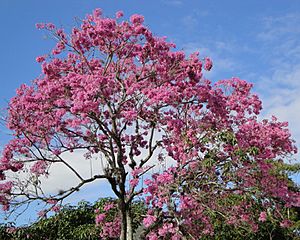Handroanthus heptaphyllus facts for kids
Quick facts for kids Handroanthus heptaphyllus |
|
|---|---|
 |
|
| Scientific classification | |
| Genus: |
Handroanthus
|
| Species: |
heptaphyllus
|
The Handroanthus heptaphyllus, often called the pink trumpet tree or pink tab, is a beautiful tree from the Bignoniaceae family. It grows naturally in warm, wet parts of South America. You can find it near big rivers like the Paraná River, Paraguay River, and Uruguay River. This tree prefers low-lying areas with rich, moist soil. It often forms part of the tall tree canopy in these forests.
The pink trumpet tree is very special to Paraguay. It was officially named the national tree of Paraguay on May 10, 2012. This happened during the celebration of Paraguay's 200th year of independence. The idea came from the School of Chemical Sciences at the National University of Asunción.
Contents
About the Pink Trumpet Tree
The pink trumpet tree can grow very tall, sometimes reaching up to 40 meters (about 130 feet). Its bark is brownish-gray and becomes quite rough with deep cracks as the tree gets older. Young pink trumpet trees need specific amounts of light and moisture. They can also be harmed by frost. Because of its lovely appearance, this tree is often planted in parks, town squares, and public green spaces.
People sometimes confuse this tree with another similar one, Handroanthus impetiginosus. They look alike, but the pink trumpet tree is usually shorter. According to a Brazilian botanist named Lúcia Lohmann, Handroanthus heptaphyllus typically grows to a maximum height of 15 meters (about 50 feet).
Leaves, Flowers, and Fruit
The leaves of the pink trumpet tree are shaped like a hand, with several leaflets spreading out from one point. Each leaf has 5 to 7 oval-shaped leaflets. These leaflets are about 10-15 cm (4-6 inches) long and have jagged edges.
This tree is semi-deciduous, meaning it loses some of its leaves. Before the new leaves appear, beautiful purple or pink tube-shaped flowers bloom. The flowers can be bright pink, pale pink, or even white.
After the flowers, the tree produces long, thin fruit pods. These pods can be up to 30–40 cm (12-16 inches) long and about 1-1.5 cm (0.4-0.6 inches) wide. When the pods are ripe, they turn brown and split open lengthwise. Each pod releases up to 150 winged seeds. The pink trumpet tree has strong, deep roots, which help it withstand strong winds.
Life Cycle
The pink trumpet tree starts to flower in early September. About a month after the flowers appear, the first leaves begin to grow. The fruit pods ripen between January and February.
Uses and Reproduction
The wood of the pink trumpet tree is very hard and heavy. There's a clear difference between the lighter outer wood (sapwood) and the darker inner wood (heartwood). The heartwood becomes even darker over time. This wood is very strong and can last a long time, even in bad weather.
People use this wood for many things, like building boats, docks, and truck beds. It's also used for beams, stairs, and floors. When the wood is cut, it produces a pale yellow sawdust. The wood also contains natural substances called tannins and pigments.
Medicinal Uses
Parts of the tree, such as the sawdust, wood chips, bark, and leaves, can be used for traditional medicinal purposes.
Reproduction
It's easy to grow new pink trumpet trees from seeds. There are about 32,000 to 35,000 seeds in one kilogram. It's best to plant the seeds quickly because they only sprout within the first 12–15 days.
You can also grow new trees from parts of the existing tree, which is called vegetative propagation. This can be done using the rootstock (the base of the tree). Some pink trumpet trees produce white flowers instead of pink ones. These "white lapachos" are often grown by grafting, which means joining a part of one tree to another.
See also
 In Spanish: Lapacho negro para niños
In Spanish: Lapacho negro para niños

